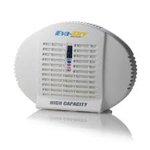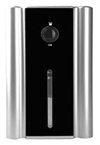Closet Dehumidifier Reviews
Here I will take a look at the closet dehumidifier, consider which type is best for a closet and briefly review some units advertised for use in closets. This page provides an overview. For more detailed information about each model mentioned on this page just follow the links which will take you to my detailed reviews of each brand.
The strong message here is that an appliance may be advertised for use in a closet but that does not mean it will make a good closet dehumidifier. I will try to explain why so that you can choose the best unit for your closet if you need one.
Thinking about a Closet Dehumidifier?
If you are thinking of buying a closet dehumidifier you have, somewhere, at least one closet, cupboard, wardrobe, cabinet, whatever your word for it, about which you are a little worried.
I say a little worried because if water was running down the walls, dripping off the shelves and forming pools on the floor you would more than a little worried, you would be on the phone now to a plumber, builder or whatever, not wasting time thinking about a closet dehumidifier.
So, you are a little worried. Perhaps some of the clothes at the back smell a little musty, or there is a small patch of mold somewhere. Maybe the printer paper you store in there feels a little cold and limp, not as crisp as it should; or it could be some of your tools have rusted slightly, and so on. Perhaps you wouldn't call it damp, but you wouldn't say it was dry either, and maybe you had better do something before things you paid good money for have to be replaced? Maybe a dehumidifier would do the trick?
Ok, so now we're in the same ball-park, that is the type of problem a closet dehumidifier is supposed to solve.
How do you decide which closet dehumidifier you need?
First, it has to be up to the job.
It saddens me to see so many websites blithely recommending a device as a "closet dehumidifier" without even referring to the huge difference in size between one "closet" and another. In your home you may have a closet or cabinet where you keep various medications for headaches, indigestion and so on. These are usually wall mounted, out of reach for small children, about a couple of feet high, a foot or so wide, maybe six to nine inches deep. You often have them in a bathroom. Then, when you've swallowed your aspirins and Alka-Seltzer for that hangover and taken your shower you get dressed.
Your clothes are kept in a closet or wardrobe. Perhaps through the pounding in your head you notice that this closet is a tad larger than the one you just visited a few minutes earlier. You may even have walked into it. Some folks' walk-in closets are bigger than other folks' bathrooms!
Next you have your coffee, you can't face food the way you feel, and you head for the garage, or maybe the basement to get your tools before you start work on your car. As you are collecting them from another closet you shiver. "It's a mite chilly in here", is the thought that crosses your mind.
Enough with the story, I'm sure you've got the picture. Closets vary in size and the places where closets are located vary in temperature. Both factors are highly relevant to the choice you're now pondering.
A Closet Dehumidifier can be any one of these types.
Rechargeable.
If you've bought a new camera, computer or some other electronic device you will have unpacked it and most probably discarded the packaging, including the little bag of desiccant that was inside the box. These are so familiar to us that we hardly notice them. We know what they are for, to absorb tiny amounts of moisture from inside the box to protect the product.
A rechargeable closet dehumidifier does exactly the same but with larger amounts of the desiccant, usually silica gel. You can buy bags of silica gel to hang or place in drawers and smaller closets. You can also buy larger bags of the desiccant to put in the bottom of an open topped container. Some of these are "use once and discard" while others can be regenerated (dried out) by heating in the oven. The open topped containers are more messy, having to be emptied when they are saturated and at risk of being knocked over, so the bags are preferred by many. This is the most basic type of closet dehumidifier.
This type works, but in small areas only. One bag would usually be enough for an average sized drawer, more than one, maybe two to four, for a stand-alone clothes closet or wardrobe.
A refinement of this type is a small unit in a plastic case that also contains desiccant crystals. A popular choice is the Eva-Dry range which, depending on model, varies in price from around $20 to $40. These too can be hung or placed in small spaces and need neither batteries nor a power cable. They run for between four and eight weeks, have an indicator which changes color when they are full and can be dried out by connecting them to the mains electricity for about ten to twelve hours.

This type is more expensive than the bags and tubs but is perhaps more appealing to some for its ease of use and more pleasing appearance. One or two should cope with a clothes closet/wardrobe, depending on size, but for the walk in closet, bigger than a bathroom, a larger number may be necessary.
Read my review of the Eva Dry Rechargeable unit.
Heated Rod
A completely different type is the Heated Rod. This consists of a rod through which an electric current runs heating the rod to a moderately hot temperature, just below 150F. This would be too hot to hold in the hand for any time but below the level at which combustion could occur. For comparison hair straighteners operate at about 400F.

This device does not absorb water it heats the air, which has two benefits. First heating the air lowers relative humidity because warm air "holds" more water than cool air. Raising relative humidity reduces or eliminates the risk of condensation.
By placing the device at the base of a closet, as recommended, it also generates air circulation by convection, warm air rising, being replaced by cold air, then itself cooling and replacing newly warmed air.
The disadvantage of this method is that the rod must be connected to a mains electricity supply. This may be inconvenient or impossible in a clothes closet for example. It is particularly suitable for use where the closet is only opened occasionally because here the air circulation is of greater benefit.
A particular, and popular, use for heated rods is in gun safes, and it would be equally suitable for an enclosed, moderately sized, storage space for tools. A popular brand is the GoldenRod.
This type of closet dehumidifier is particularly suitable for enclosed storage cabinets located in cool areas, such as a garage, where the lower temperature results in higher relative humidity, increasing the risk of condensation.
Read my reviews of the GoldenRod models here.

Thermo-Electric
Also marketed as closet dehumidifiers are small Thermo-Electric models. An example is the Sunpentown SD652. These units operate using the "Peltier Process" and are also recommended by sellers for smaller rooms in the house. They have a very low water extraction rate and are less energy efficient than a conventional portable.
The main advantage claimed for these appliances is that they are quiet because they do not need a compressor. They do, however, have a fan and consumer reviews confirm that they are not as quiet as is sometimes claimed. They are, in my view, not powerful enough to be effective in a room, even a small one. They may be sufficient, however, for a smaller walk-in closet. The principal disadvantage of this type is that it requires a permanent mains electricity supply so a cable will have to run from the appliance to a power socket elsewhere in the room.
This is not a type that I recommend for use in a closet but you may read my review of the Sunpentown SD652 here
My recommendation for very large, and particularly walk-in, closets would be to dry the air throughout the whole room, usually a bedroom, and leave the closet doors open, or at least ajar, during the day.
If you have a whole-house dehumidifier already and have concerns about one or more closets, leaving the doors open will probably be sufficient. If you have not it is advisable to use a unit large enough to cope with the room in question and run it with the closet doors open and the room door and windows closed.
If it is only, for example, drawers within the closet where there is evidence of moisture a rechargeable closet dehumidifier will be sufficient if placed in the drawer, which should then be closed.
Search our Site
Frequently Asked Questions
If you have a question why not try ourFAQs Page
Ask a Question
If you can't find the answer you need we will reply to your question here. Just type your question into the form on our
Ask a Question Page
Make a Comment
If you would like to comment on our site, to tell us we've done a good job or to suggest improvements, please click on
Visitor Comments






